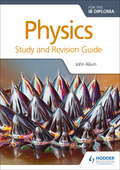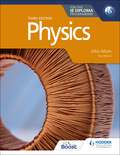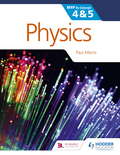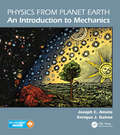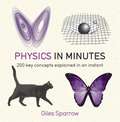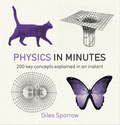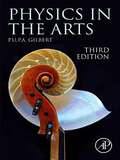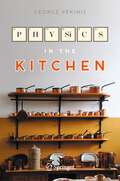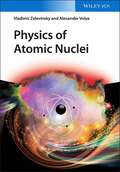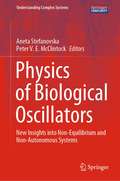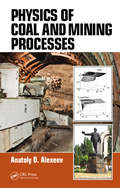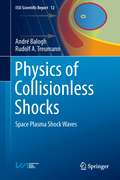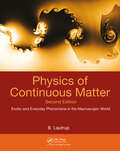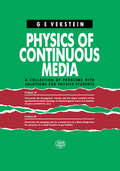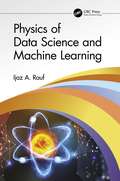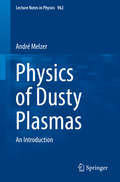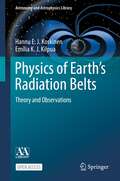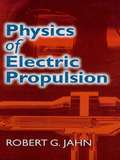- Table View
- List View
Physics for the IB Diploma Study and Revision Guide
by John AllumExam Board: IBLevel: IBSubject: PhysicsFirst Teaching: September 2014First Exam: Summer 2016Stretch your students to achieve their best grade with these year round course companions; providing clear and concise explanations of all syllabus requirements and topics, and practice questions to support and strengthen learning. - Consolidate revision and support learning with a range of exam practice questions and concise and accessible revision notes- Practise exam technique with tips and trusted guidance from examiners on how to tackle questions- Focus revision with key terms and definitions listed for each topic/sub topic
Physics for the IB Diploma Third edition (For the IB Diploma)
by John AllumDeveloped in cooperation with the International Baccalaureate®Trust experienced and best-selling authors to navigate the new syllabuses confidently with these coursebooks that implement inquiry-based and conceptually-focused teaching and learning.- Ensure a continuum approach to concept-based learning through active student inquiry; our authors are not only IB Diploma experienced teachers but are also experienced in teaching the IB MYP and have collaborated on our popular MYP by Concept series.- Build the skills and techniques covered in the Tools (Experimental techniques, Technology and Mathematics) with direct links to the relevant parts of the syllabus; these skills also provide the foundation for practical work and internal assessment.- Integrate Theory of Knowledge into your lessons with TOK boxes and Inquiries that provide real-world examples, case studies and questions. The TOK links are written by the author of our bestselling TOK coursebook, John Sprague and Paul Morris, our MYP by Concept series and Physics co-author.- Develop approaches to learning with ATL skills identified and developed with a range of engaging activities with real-world applications.- Explore ethical debates and how scientists work in the 21st century with Nature of Science boxes throughout.- Help build international mindedness by exploring how the exchange of information and ideas across national boundaries has been essential to the progress of science and illustrates the international aspects of science.- Consolidate skills and improve exam performance with short and simple knowledge-checking questions, exam-style questions, and hints to help avoid common mistakes.Free online contentGo to our website www.hoddereducation.com/ib-extras for free access to the following:- Practice exam-style questions for each chapter- Glossary- Answers to self-assessment questions and practice exam-style questions- Tools and Inquiries reference guide- Internal Assessment - the scientific investigation
Physics for the IB Diploma Third edition (For the IB Diploma)
by John AllumDeveloped in cooperation with the International Baccalaureate®Trust experienced and best-selling authors to navigate the new syllabuses confidently with these coursebooks that implement inquiry-based and conceptually-focused teaching and learning.- Ensure a continuum approach to concept-based learning through active student inquiry; our authors are not only IB Diploma experienced teachers but are also experienced in teaching the IB MYP and have collaborated on our popular MYP by Concept series.- Build the skills and techniques covered in the Tools (Experimental techniques, Technology and Mathematics) with direct links to the relevant parts of the syllabus; these skills also provide the foundation for practical work and internal assessment.- Integrate Theory of Knowledge into your lessons with TOK boxes and Inquiries that provide real-world examples, case studies and questions. The TOK links are written by the author of our bestselling TOK coursebook, John Sprague and Paul Morris, our MYP by Concept series and Physics co-author.- Develop approaches to learning with ATL skills identified and developed with a range of engaging activities with real-world applications.- Explore ethical debates and how scientists work in the 21st century with Nature of Science boxes throughout.- Help build international mindedness by exploring how the exchange of information and ideas across national boundaries has been essential to the progress of science and illustrates the international aspects of science.- Consolidate skills and improve exam performance with short and simple knowledge-checking questions, exam-style questions, and hints to help avoid common mistakes.Free online contentGo to our website www.hoddereducation.com/ib-extras for free access to the following:- Practice exam-style questions for each chapter- Glossary- Answers to self-assessment questions and practice exam-style questions- Tools and Inquiries reference guide- Internal Assessment - the scientific investigation
Physics for the IB MYP 4 & 5: By Concept
by Paul MorrisMYP by Concept is the only series for years 4 and 5 developed with the IB.Drive meaningful inquiry for the new framework through a unique concept driven narrative.- Supports every aspect of assessment with opportunities that use the criteria- Gives you easy ways to differentiate and extend learning- Provides a meaningful approach by integrating the inquiry statement in a global context- Develops critical-thinking skills with activities and summative sections rooted in the ATL frameworkAlso coming soon are Teaching and Learning Resources and eTextbooks via Dynamic Learning, our complete digital solution
Physics for the IB MYP 4 & 5: By Concept (MYP By Concept)
by Paul MorrisThe only series for MYP 4 and 5 developed in cooperation with the International Baccalaureate (IB)Develop your skills to become an inquiring learner; ensure you navigate the MYP framework with confidence using a concept-driven and assessment-focused approach presented in global contexts.- Develop conceptual understanding with key MYP concepts and related concepts at the heart of each chapter.- Learn by asking questions with a statement of inquiry in each chapter. - Prepare for every aspect of assessment using support and tasks designed by experienced educators.- Understand how to extend your learning through research projects and interdisciplinary opportunities.This title is also available in two digital formats via Dynamic Learning. Find out more by clicking on the links at the top of the page.
Physics from Planet Earth - An Introduction to Mechanics
by Enrique J. Galvez Joseph C. AmatoExpose Your Students to the Elegant World of Physics in an Enticing WayPhysics from Planet Earth - An Introduction to Mechanics provides a one-semester, calculus-based introduction to classical mechanics for first-year undergraduate students studying physics, chemistry, astronomy, or engineering. Developed from classroom-tested materials refined an
Physics in Minutes
by Giles SparrowPhysics in Minutes covers everything you need to know about physics, condensed into 200 key topics. Each idea is explained in clear, accessible language, building from the basics, such as mechanics, waves, and particles, to more complex topics, including neutrinos, string theory, and dark matter.Following the latest scientific research proving that the brain best absorbs information visually, each description is accompanied by an illustration to aid quick comprehension and easy recollection. This convenient and compact reference book is ideal for anyone interested in how our world works.Chapters include: Newton's Laws of Motion, Schrodinger's cat, Magnetism, Superconductivity, Fission and fusion, Higgs Boson, Entropy, Dark matter.
Physics in Minutes
by Giles SparrowPhysics in Minutes covers everything you need to know about physics, condensed into 200 key topics. Each idea is explained in clear, accessible language, building from the basics, such as mechanics, waves and particles, to more complex topics, including neutrinos, string theory and dark matter. Based on scientific research proving that the brain best absorbs information visually, illustrations accompany the text to aid quick comprehension and easy recollection. This convenient and compact reference book is ideal for anyone interested in how our world works. Chapters include: Newton's Laws of Motion, Schrödinger's cat, Magnetism, Superconductivity, Fission and fusion, Higgs Boson, Entropy, Dark matter.
Physics in Minutes (IN MINUTES)
by Giles SparrowPhysics in Minutes covers everything you need to know about physics, condensed into 200 key topics. Each idea is explained in clear, accessible language, building from the basics, such as mechanics, waves and particles, to more complex topics, including neutrinos, string theory and dark matter. Based on scientific research proving that the brain best absorbs information visually, illustrations accompany the text to aid quick comprehension and easy recollection. This convenient and compact reference book is ideal for anyone interested in how our world works. Chapters include: Newton's Laws of Motion, Schrödinger's cat, Magnetism, Superconductivity, Fission and fusion, Higgs Boson, Entropy, Dark matter.
Physics in a New Era: An Overview
by Physics Survey Overview CommitteePhysics at the beginning of the twenty-first century has reached new levels of accomplishment and impact in a society and nation that are changing rapidly. Accomplishments have led us into the information age and fueled broad technological and economic development. The pace of discovery is quickening and stronger links with other fields such as the biological sciences are being developed. The intellectual reach has never been greater, and the questions being asked are more ambitious than ever before. Physics in a New Era is the final report of the NRC’s six-volume decadal physics survey. The book reviews the frontiers of physics research, examines the role of physics in our society, and makes recommendations designed to strengthen physics and its ability to serve important needs such as national security, the economy, information technology, and education.
Physics in the Arts
by Pupa U.P.A. GilbertPhysics in the Arts, Third Edition gives science enthusiasts and liberal arts students an engaging, accessible exploration of physical phenomena, particularly with regard to sound and light. This book offers an alternative route to science literacy for those interested in the arts, music and photography. Suitable for a typical course on sound and light for non-science majors, Gilbert and Haeberli's trusted text covers the nature of sound and sound perception as well as important concepts and topics such as light and light waves, reflection and refraction, lenses, the eye and the ear, photography, color and color vision, and additive and subtractive color mixing. Additional sections cover color generating mechanisms, periodic oscillations, simple harmonic motion, damped oscillations and resonance, vibration of strings, Fourier analysis, musical scales and musical instruments.
Physics in the Kitchen (Copernicus Books)
by George VekinisDo you know why honey drips whereas ketchup refuses to budge in the bottle? Or what kettles have in common with power stations, or how to cook with radar? This delightful and accessible book provides a smorgasbord and a whirlwind tour of the multitude of physical phenomena that occur in a kitchen: from the diffusion of nutrients during cooking to how an extractor fan works, how smells disperse, and where quantum effects are hidden. These and numerous other fascinating phenomena are served up in an engaging manner that will fascinate and tantalise the taste buds of anyone who enjoys eating, cooking or simply spending time in the kitchen. No specialist technical or mathematical knowledge is required to enjoy this book. Tuck right in and discover the universe of physical laws in your very own kitchen...
Physics in the Universe (HMH Science Dimensions™)
by John Galisky Jeffrey RylanderNIMAC-sourced textbook
Physics of Atomic Nuclei
by Alexander Volya Vladimir ZelevinskyThis advanced textbook presents an extensive and diverse study of low-energy nuclear physics considering the nucleus as a quantum system of strongly interacting constituents. The contents guide students from the basic facts and ideas to more modern topics including important developments over the last 20 years, resulting in a comprehensive collection of major modern-day nuclear models otherwise unavailable in the current literature. The book emphasizes the common features of the nucleus and other many-body mesoscopic systems currently in the center of interest in physics. The authors have also included full problem sets that can be selected by lecturers and adjusted to specific interests for more advanced students, with many chapters containing links to freely available computer code. As a result, readers are equipped for scientific work in mesoscopic physics.
Physics of Biological Oscillators: New Insights into Non-Equilibrium and Non-Autonomous Systems (Understanding Complex Systems)
by Aneta Stefanovska Peter V. E. McClintockThis book, based on a selection of invited presentations from a topical workshop, focusses on time-variable oscillations and their interactions. The problem is challenging, because the origin of the time variability is usually unknown. In mathematical terms, the oscillations are non-autonomous, reflecting the physics of open systems where the function of each oscillator is affected by its environment. Time-frequency analysis being essential, recent advances in this area, including wavelet phase coherence analysis and nonlinear mode decomposition, are discussed. Some applications to biology and physiology are described.Although the most important manifestation of time-variable oscillations is arguably in biology, they also crop up in, e.g. astrophysics, or for electrons on superfluid helium. The book brings together the research of the best international experts in seemingly very different disciplinary areas.
Physics of Coal and Mining Processes
by Anatoly D. AlexeevAround the world, on average, four coal miners die for each million tons of coal recovered. Improving the safety of mining work while responding to the need for increased coal production, however, is impossible without further development of the physics of mining processes. A relatively new branch of science, it tackles problems that arise during m
Physics of Collisionless Shocks
by Rudolf A. Treumann André BaloghThe present book provides a contemporary systematic treatment of shock waves in high-temperature collisionless plasmas as are encountered in near Earth space and in Astrophysics. It consists of two parts. Part I develops the complete theory of shocks in dilute hot plasmas under the assumption of absence of collisions among the charged particles when the interaction is mediated solely by the self-consistent electromagnetic fields. Such shocks are naturally magnetised implying that the magnetic field plays an important role in their evolution and dynamics. This part treats subcritical shocks which dissipate flow energy by generating anomalous resistance or viscosity. The main emphasis is, however, on super-critical shocks where the anomalous dissipation is insufficient to retard the upstream flow. These shocks, depending on the direction of the upstream magnetic field, are distinguished as quasi-perpendicular and quasi-parallel shocks which exhibit different behaviours, reflecting particles back upstream and generating high electromagnetic wave intensities. Particle acceleration and turbulence at such shocks become possible and important. Part II treats planetary bow shocks and the famous Heliospheric Termination shock as examples of two applications of the theory developed in part I.
Physics of Continuous Matter: Exotic and Everyday Phenomena in the Macroscopic World
by B. LautrupPhysics of Continuous Matter: Exotic and Everyday Phenomena in the Macroscopic World, Second Edition provides an introduction to the basic ideas of continuum physics and their application to a wealth of macroscopic phenomena. The text focuses on the many approximate methods that offer insight into the rich physics hidden in fundamental continuum me
Physics of Continuous Media: A Collection of Problems With Solutions for Physics Students
by G.E. VeksteinThis textbook is based on lectures and tutorials given for several years at the Physics Department of Novosibirsk State University. It is constructed as a set of problems followed by detailed solutions and may act as a complementary text for standard courses on the physics of continuous media.
Physics of Daily Life First Semester FYBA, B.COM, B.SC New NEP Syllabus - SPPU
by Dr R. B. Bhise Dr A. B. Bhorde Dr M. S. Shinde Dr M. D. Dhiware R. G. Waykar Dr T. P. Gujar"Physics of Daily Life" is an introductory textbook designed for first-year undergraduate students (B.Sc., B.A., and B.Com) following the National Education Policy (NEP) syllabus of 2024. The book simplifies fundamental physics concepts and demonstrates their applications in everyday life, making them accessible to students from diverse academic backgrounds. It covers various topics, including atmospheric physics, human body mechanics, sports physics, and technological applications. The book explains physical principles like Pascal’s law, Archimedes’ principle, and Rayleigh scattering, alongside their real-world implications, such as weather systems, optical instruments, and modern technologies like GPS, lasers, and electric motors. Written in a clear and structured manner, it integrates theoretical explanations with practical examples to enhance comprehension.
Physics of Data Science and Machine Learning
by Ijaz A. RaufPhysics of Data Science and Machine Learning links fundamental concepts of physics to data science, machine learning and artificial intelligence for physicists looking to integrate these techniques into their work. This book is written explicitly for physicists, marrying quantum and statistical mechanics with modern data mining, data science, and machine learning. It also explains how to integrate these techniques into the design of experiments, whilst exploring neural networks and machine learning building on fundamental concepts of statistical and quantum mechanics. This book is a self-learning tool for physicists looking to learn how to utilize data science and machine learning in their research. It will also be of interest to computer scientists and applied mathematicians, alongside graduate students looking to understand the basic concepts and foundations of data science, machine learning, and artificial intelligence. Although specifically written for physicists, it will also help provide non-physicists with an opportunity to understand the fundamental concepts from a physics perspective to aid the development of new and innovative machine learning and artificial intelligence tools. Key features: Introduces the design of experiments and digital twin concepts in simple lay terms for physicists to understand, adopt, and adapt. Free from endless derivations, instead equations are presented and explained strategically and explain why it is imperative to use them and how they will help in the task at hand. Illustrations and simple explanations help readers visualize and absorb the difficult to understand concepts. Ijaz A. Rauf is Adjunct Professor at the School of Graduate Studies, York University, Toronto, Canada. He is also an Associate Researcher at Ryerson University, Toronto, Canada and President of the Eminent-Tech Corporation, Bradford, ON, Canada.
Physics of Dusty Plasmas: An Introduction (Lecture Notes in Physics #962)
by André MelzerColloidal plasmas - a still emerging field of plasma physics - enable the study of basic plasma properties on a microscopic kinetic level and allow the visualization of collective plasma phenomena, like oscillations and waves. Moreover, a vast number of novel phenomena are found in these systems, ranging from Coulomb crystallization to new types of forces and waves. Last but not least, they shed a new light on various traditional aspects of plasma physics such as shielding or the mechanism of acoustic waves in plasmas, thus providing new insight into the basic foundations of plasma physics.These course-based and self-contained lecture notes provide a general introduction to this active and growing field to students and nonspecialists, requiring only basic prior knowledge in plasma physics.
Physics of Earth’s Radiation Belts: Theory and Observations (Astronomy and Astrophysics Library)
by Hannu E. Koskinen Emilia K. KilpuaThis open access book serves as textbook on the physics of the radiation belts surrounding the Earth. Discovered in 1958 the famous Van Allen Radiation belts were among the first scientific discoveries of the Space Age. Throughout the following decades the belts have been under intensive investigation motivated by the risks of radiation hazards they expose to electronics and humans on spacecraft in the Earth’s inner magnetosphere. This textbook teaches the field from basic theory of particles and plasmas to observations which culminated in the highly successful Van Allen Probes Mission of NASA in 2012-2019. Using numerous data examples the authors explain the relevant concepts and theoretical background of the extremely complex radiation belt region, with the emphasis on giving a comprehensive and coherent understanding of physical processes affecting the dynamics of the belts. The target audience are doctoral students and young researchers who wish to learn about the physical processes underlying the acceleration, transport and loss of the radiation belt particles in the perspective of the state-of-the-art observations.
Physics of Electric Propulsion
by Robert G. JahnGeared toward advanced undergraduates and graduate students, this text systematically develops the concepts of electrical acceleration of gases for propulsion. Author Robert G. Jahn, Professor of Aerospace Sciences at Princeton University, starts his presentation with primary physical principles and concludes with realistic space thruster designs.Part I consists of a survey of those aspects of electricity, magnetism, and ionized gas mechanics that underlie the physical mechanisms for gas acceleration. These topics constitute the main body of the text. Part II's broad division into the categories of electrothermal, electrostatic, and electromagnetic acceleration mechanisms conforms to the historical development of the field and offers conceptual organization for new students.
